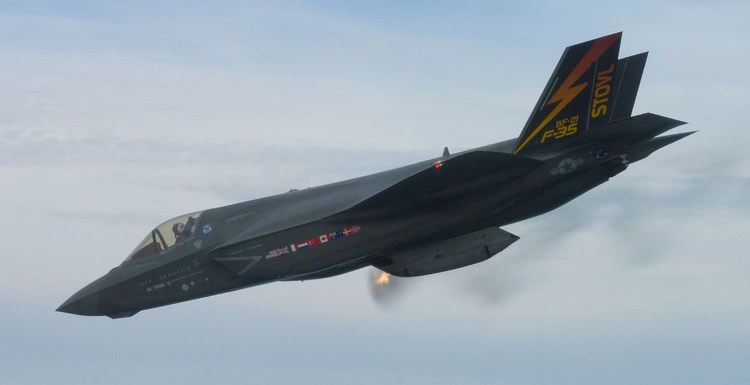The F-35 Program
The F-35 program has dominated the 21st Century aviation headlines and has been a source of praise and criticism. With cost figures in the Trillions, the Department of Defense focused most of its resources and efforts on the research, development, and delivery of the F-35 series of 5th Generation aircraft for the Air Force, Marines, and Navy. The F-35 program is comprised of the Air Force “A” variation, the Marine Short Take Off Vertical Landing “B” variation, and the Navy “C” model. I have doubted the F-35 due to primarily the cost and opportunity cost, or cost of missing out on other aircraft that may have been built. Still in its infancy of operation, I have been pleasantly surprised by the performance and capabilities of the F-35. The program has been catapulted into operational lethality and performance by the determination of Air Force, Marine, and Navy aviators and their engineering support staff. We all eagerly await what comes next.
The Air Force’s Next Generation Air Dominance and FA/XX programs are currently in progress, and the NGAD program has shown the world the speed and prowess of the research and development capabilities within the grasp of Air Force decision-makers. These capabilities have been furthered by rapid prototyping and the construction of aircraft for demonstration. With the 5th Generation stealth F-35s operationally spread across the various aviation branches, we are asking what is the next fighter. What will replace and or complement the F-35 and the F-22?
Aviation Research, Development, and Prototyping Empire Created by the F-35 Program
I would argue that the Trillions allocated to the F-35 are just the tip of the iceberg of the value and potential value created by developing the F-35 5th Generation program. The main value rests in the creation of a Research, Development, and Prototyping Empire that is currently at the fingertips of DoD leadership. With the technical competency in emerging digital engineering that has never been seen before, I look forward to the golden age of military aircraft design, manufacturing, and operation.
The Air Force’s Next Generation Air Dominance program and the FA/XX Naval Aviation programs will both greatly benefit from the Engineering Empire created by the F-35.
Moving forward into the 6th Generation and beyond aircraft, there is careful analysis and direction by military aviation leadership.
Traditional Fighter Programs vs Light Fighter Programs
Traditional aviation programs take decades from concept to flight and operation of military aircraft. This also requires acquisition challenges and extremely high costs of research, development, engineering, and competition. The military creates a fleet of a designation of aircraft to be used for decades of service life. This has its disadvantages in cost and time to go from concept to delivery of a fleet of aircraft. The advantage of traditional aviation programs is that the DoD can use larger aerospace companies for the manufacture and operations of the aircraft.
Light fighter programs are conceptually quicker from concept to development, and they may be in less quantity with potentially modular design. With the advances in research and development through 21st century digital engineering, the planes can be prototyped and potentially manufactured in a fraction of the traditional programs. This rapid development also allows healthier competition, including smaller venture businesses. This can catapult new aircraft into operation, yet it also has disadvantages. With large amounts of funding at stake in aerospace and aviation projects, there is rightfully so much deliberation in the acquisition programs at all levels. Gaining government approval for these projects can cause arguments between legislators and sometimes cause cancellation or delays of good programs.
The F-35 Program
The F-35 program has dominated the 21st Century aviation headlines and has been a source of praise and criticism. With cost figures in the Trillions, the Department of Defense focused most of its resources and efforts on the research, development, and delivery of the F-35 series of 5th Generation aircraft for the Air Force, Marines, and Navy. The F-35 program is comprised of the Air Force “A” variation, the Marine Short Take Off Vertical Landing “B” variation, and the Navy “C” model. I have doubted the F-35 due to primarily the cost and opportunity cost, or cost of missing out on other aircraft that may have been built. Still in its infancy of operation, I have been pleasantly surprised by the performance and capabilities of the F-35. The program has been catapulted into operational lethality and performance by the determination of Air Force, Marine, and Navy aviators and their engineering support staff. We all eagerly await what comes next.
The Air Force’s Next Generation Air Dominance and FA/XX programs are currently in progress, and the NGAD program has shown the world the speed and prowess of the research and development capabilities within the grasp of Air Force decision-makers. These capabilities have been furthered by rapid prototyping and the construction of aircraft for demonstration. With the 5th Generation stealth F-35s operationally spread across the various aviation branches, we are asking what is the next fighter. What will replace and or complement the F-35 and the F-22?
Aviation Research, Development, and Prototyping Empire Created by the F-35 Program
I would argue that the Trillions allocated to the F-35 are just the tip of the iceberg of the value and potential value created by developing the F-35 5th Generation program. The main value rests in the creation of a Research, Development, and Prototyping Empire that is currently at the fingertips of DoD leadership. With the technical competency in emerging digital engineering that has never been seen before, I look forward to the golden age of military aircraft design, manufacturing, and operation.
The Air Force’s Next Generation Air Dominance program and the FA/XX Naval Aviation programs will both greatly benefit from the Engineering Empire created by the F-35.
Moving forward into the 6th Generation and beyond aircraft, there is careful analysis and direction by military aviation leadership.
Traditional Fighter Programs vs Light Fighter Programs
Traditional aviation programs take decades from concept to flight and operation of military aircraft. This also requires acquisition challenges and extremely high costs of research, development, engineering, and competition. The military creates a fleet of a designation of aircraft to be used for decades of service life. This has its disadvantages in cost and time to go from concept to delivery of a fleet of aircraft. The advantage of traditional aviation programs is that the DoD can use larger aerospace companies for the manufacture and operations of the aircraft.
Light fighter programs are conceptually quicker from concept to development, and they may be in less quantity with potentially modular design. With the advances in research and development through 21st century digital engineering, the planes can be prototyped and potentially manufactured in a fraction of the traditional programs. This rapid development also allows healthier competition, including smaller venture businesses. This can catapult new aircraft into operation, yet it also has disadvantages. With large amounts of funding at stake in aerospace and aviation projects, there is rightfully so much deliberation in the acquisition programs at all levels. Gaining government approval for these projects can cause arguments between legislators and sometimes cause cancellation or delays of good programs.
Traditional Fighter Programs can coexist with Purpose Driven Smaller Fighter Programs
There is nothing that says the DoD must choose a traditional fleet concept or a purpose-driven, smaller quantity, and diversified fleet concept. Why must we do one type or the other? The traditional methods of aerospace programs reduce risk as they allow established firms to compete and win larger contracts for manufacture and operation. They allow larger companies to maximize the opportunity for the success of expensive aircraft with longer life cycles. A hybrid system where both traditional aircraft programs and purpose-driven smaller programs are entirely possible and advisable. A targeted percentage could be planned. The Air Force, Marines, or Navy could potentially say, “Let’s design and develop 70% in the traditional manner while designing and developing 30% in a purpose-driven/smaller quantity fashion.” This would draw from the best of both methods and give the various branches a core fleet of traditionally designed aircraft while also leveraging the 21st-century Engineering techniques and competition of smaller programs.
—
Disclaimer: SOFREP utilizes AI for image generation and article research. Occasionally, it’s like handing a chimpanzee the keys to your liquor cabinet. It’s not always perfect and if a mistake is made, we own up to it full stop. In a world where information comes at us in tidal waves, it is an important tool that helps us sift through the brass for live rounds.



